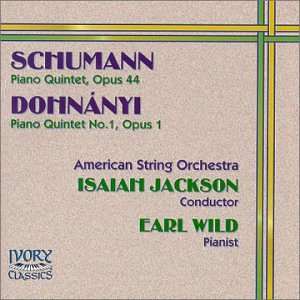|
You are reading the older HTML site
Positive Feedback ISSUE 68
Schumann and Dohnányi Piano Quintets Arranged for Piano and String Orchestra
SCHUMANN: Piano Quintet in E-flat, Op. 44. DOHNÁNYI: Piano Quintet in C minor, Op. 1. Earl Wild (piano); American String Orchestra/Isaiah Jackson. Ivory Classics 64405-71003. TT: 61.06 Downloads: HDtracks.com (lossless); general-files.com; emusic.com; iTunes; Amazon.com (scherzos only). I've always enjoyed "expanded" versions of chamber music—I realize there are those who do not -- but I wasn't so sure about these quintets. It's difficult enough to maintain equilibrium between the grand piano and the strings, as the piano tends naturally to dominate; expansion risks transforming the intended give-and-take among the five parts into an inappropriately concerto-like opposition of piano and strings. The notes, approvingly quoting Alfred R. Neuman—"Schumann condensed an orchestral accompaniment of a piano concerto into the string parts of this quintet"—made me fear the worst. In fact, each of these performances works splendidly in its own way. In the Schumann, in fact, the effect is quite the opposite of what Neuman's quote suggests. With the additional body and weight of an ensemble of multiple players, the string parts coalesce into a single "string unit" that can hold its own with the piano. In the first movement, the two units—strings and piano—thus function, not as antagonists, but as collaborators working towards a unified artistic purpose, conveying the movement's quasi-"symphonic" drama. The opening of the slow movement suffers some loss of intimacy—it seems oddly impersonal. But the turbulence of the movement's central section is more easily realized than usual—it's another passage where solo strings sometimes have to fight the piano—and there's a lovely gravitas to the reprise of the opening theme. The final high string chord shimmers here as it rarely does with soloists. The rollicking Scherzo is good—the string sections are perhaps a bit more cautious than soloists might have been -- and so is the taut finale. Conversely, Dohnányi's quintet, couched in the sweeping rhetoric of late Romanticism, seems always to be straining at the limits of the chamber sonority. Thus, the present expanded performance sounds better adapted to the music's broad expressive strokes. The strings' "orchestral" weight and presence brings a new stature to the first movement, where the big string unison at 7.21 makes luminous sense; so does the trenchant Scherzo—surely Dohnányi was thinking multiple strings here. The Adagio: quasi andante begins fervently, though as the sonorities expand, the manner becomes rather forward, almost aggressive. In the finale, the broad melodic gestures sound entirely apt, while the dancey second subject is buoyant whenever it appears. Earl Wild appears to have been the motivator, if not the instigator, of the present program. Although a justly renowned virtuoso, he doesn't treat the piano part as a showcase for himself—except, perhaps, in the musicality and aplomb with which he meets its admittedly fearsome demands. Otherwise, he draws maximum expression and power from the music, while fitting into the overall sonic frame. Isaiah Jackson gets draws impassioned yet disciplined playing from his "American String Orchestra," presumably drawn from members of the Youngstown Symphony, where he was Music Director at the time of recording. A few rough, passing moments have possibly been magnified by the vivid but rather close recording. Try it. You might like it - I did.
|

